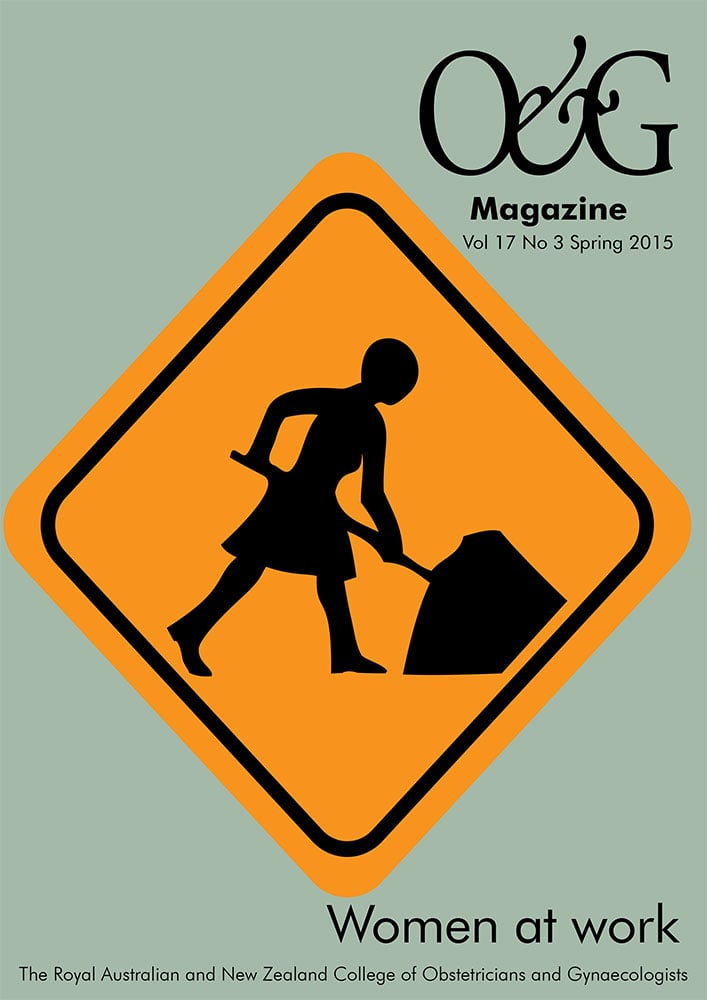In 1973, when I graduated as one of eight women in the first group of medical students from the new University of Auckland School of Medicine, I was filled with optimism about my professional future. I was largely unaware of any barriers I might meet professionally because I was a woman. Perhaps this was because as a first graduating class we received special attention from our teachers or perhaps because it was the general optimism of the time. For me, this optimism was best captured by the Pointer Sisters’ hit song ‘Yes We Can’, and its lyrics that focused on building a better world through hard work and kindness.
I moved to Australia immediately after graduation. In the early 1970s, women made up only 13 per cent of medical practitioners and were strikingly under-represented in our specialty. In Sydney, where I undertook my training, there were only a handful of female specialists and no women in training positions. Despite obstetrics and gynaecology being a popular specialty with female students, the training environment, demands of specialty practice and lack of role models discouraged women from entering the specialty. Trainees commonly worked a 24 hours on duty one-in-four roster during the week in addition to daytime duties and 48 hours on duty at weekends. Maternity leave was available, but not ‘encouraged’. My entry interview into the specialty included direct questioning of my contraceptive practice. The majority of specialists after completing training worked in solo private practice, with honorary hospital appointments. Securing a position at one of the larger academic hospitals generally required a Trainee to have completed a period of international training.
Increasing feminisation of medicine
In the 40 years since I commenced my specialist training, the proportion of women attending medical schools and choosing to specialise in obstetrics and gynaecology has steadily risen in Australia and New Zealand along with most developed counties. In 2010, the 13th Australian Medical Training Review Panel report for the Department of Health demonstrated one of the highest percentages of female basic trainees occurred in obstetrics and gynaecology (65 per cent), in comparison with the overall average (47 per cent) for other specialties.
Over the last four decades, substantial changes have occurred in the medical work and training environment. Long hours and largely unstructured training have been replaced with regulated work conditions (largely imposed by external agencies and a unionised workforce) and a modular, structured approach to training. These changes have encouraged more women to enter medicine, and with it our specialty, and have better enabled them to meet their professional and personal needs.
Changing medical professionalism
The progressive feminisation of the medical workforce has been mirrored by a significant change in what constitutes medical professionalism. This is defined by the Royal College of Physicians as the set of values, behaviours and relationships that underpin the trust the public has in doctors.1 A review of the contemporary literature suggests medical professionalism has undergone significant change in five distinct dimensions: from physician autonomy to working collaboratively; from individual professional judgment to evidence-based care; from personal responsibility to public accountability for outcomes; from personal control to shared responsibility; and from doctor-led spending to shared responsibility for appropriate allocation of resources.
Is this change a consequence of the feminisation of the medical workforce? It is difficult to know for sure, however, what can be said is that women are perhaps more likely to naturally embody these principles of new medical professionalism. Women are typically more sensitive to patients’ physical and emotional concerns and more likely than their male counterparts to engage patients as active partners in their care.2 Female doctors may also be more inclined towards a team-based approach to care.3 4
Impact on status of medicine
It has been suggested that the increased feminisation of the medical workforce would result in a decline in the status of the profession. In Russia and Estonia, where women have long dominated medicine, the profession is considered a low-status occupation.5 6 However, a decline in status does not appear to have occurred in the Western world. A Roy Morgan survey showed that the percentage of Australians who rate doctors as having high to very high ethics and honesty increased from 63 per cent in 1986 to 86 per cent in 2014. In the same year, United States data showed medical professionals to have the highest annual mean wages of all professional groups.7 However, the income of doctors in the UK, US, Australia and New Zealand appears to be less for female doctors than for male doctors.8 The reasons for this are complex, but one factor is women are more likely to choose workplace flexibility and fewer on-call hours over a higher salary in order to preserve a work-life balance.
Impact on workforce productivity
There is some evidence that women engage in more patient centred communication and spend longer with patients. In the UK, NHS-employed, full-time female consultants see fewer patients than their male colleagues.9 Interestingly, despite apparent differences in communication approaches and time spent with patients, studies do not consistently show higher patient satisfaction with female physicians.10 While this information suggests that, as a group, women bring empathy and excellent communication skills to their patient contacts, this may be at the expense of productivity, something also valued in our resource-pressured healthcare environment.
How women’s desire for more flexible work schedules translates into their contribution to the medical workforce over the course of their working lives is less clear. Reports from the 1990s and early 2000s showed women worked a shorter week and were likely to retire earlier than men.11 12 In 2013, the AMA reported the median retirement age for obstetrician gynaecologists in the United States was 64 and women, on average, retired five years earlier than men.13
Lifestyle and career choices
The lifestyle challenges and issues that were traditionally the concern of women would now seem to be important to medical students and trainees both male and female.14 15 Parenting physicians of both genders now actively seek to find a balance between their professional career and personal life, although the trend to working reduced hours is still more apparent with female physicians.16 This trend is reflected across all work environments and is an inevitable consequence of the changing life values of our younger generations. As more doctors seek a work-life and work-family balance, we are becoming increasingly challenged to develop creative models for training and professional practice that will ensure well-trained specialists who have productive and satisfying professional lives.
At the end
As I draw closer to the end of my active professional life, it is gratifying to find women have gained a greater presence and stronger voice within our specialty. There is still a need for women to be more prominent in positions of influence and leadership. There is a tendency for change in medicine to occur with wide swings of the pendulum and then to settle to a more moderate position. The feminisation of our obstetrics and gynaecology workforce is an example of this. There is value in a diverse workforce united in a common purpose. Our specialty would be disadvantaged if we were to lose the skills and perspective that men bring to it. I trust the pendulum of change in this respect will find a sensible resting place.
It seems to me the workforce and training challenges we are facing in our specialty are not so much created by the feminisation of our workforce, but rather by the change in societal values. Once again, this is perhaps best summed by the music of the time, as Jon Bon Jovi so memorably declared: ‘It’s my life. It’s now or never…I just want to live while I’m alive.’
References
- Report of a Working Party of the Royal College of Physicians of London. Doctors in society Medical professionalism in a changing world. London: RCP, 2005.
- Roter D, Hall J, Aoki Y. Physician gender effects in medical communication: a meta-analytic review. JAMA. 2002; 288(6):756-64.
- Eagly AH, Johnson BT. Gender and leadership style: a meta-analysis. Psychol Bull. Vol 108(2), Sep 1990, 233-256.
- Eagly AH, Johannesen-Schmidt MC, van Engen ML. Transformational, transactional, and laissez-faire leadership styles: a meta-analysis comparing women and men. Psychol Bull. Vol 129(4), Jul 2003,
569-591. - Harden J. ‘Mother Russia’ at work: gender divisions in the medical profession. The European Journal of Women’s Studies. 2001; 8 (2):181-99.
- Barr DA, Boyle EH. Gender and professional purity: explaining formal and informal work rewards for physicians in Estonia. Gender & Society. 2001; 15:29-54.
- National Occupational Employment and Wage Estimates United States. May 2014. Available from: www.bls.gov/oes/current/oes_nat.htm .
- Weizblit N, Noble J, Baerlocher MO. The feminisation of Canadian medicine and its impact upon doctor productivity. Med Educ. 2009; 43(5): 442-448.
- Bloor K, Freemantle N, Maynard A. Gender and variation in activity rates of hospital consultants. J R Soc Med 2008;101(1):27-33.
- Hall JA, Roter DL. Medical communication and gender: a summary of research. J Gend Specif Med. 1998;1(2):39-42.
- Batchelor AJ. Senior women physicians: the question of retirement. N Y State J Med. 1990; 90(6):292-4.
- Australian Medical Workforce Advisory Committee (2004), The Specialist Obstetrics and Gynaecology Workforces in Australia. An Update 2003-2013. AMWAC Report 2004.2, Sydney. Available from: www.hwa.gov.au/sites/uploads/Specialist%20obstetrics%20and%20gynaecology%20workforces%20in%20Australia.pdf .
- Rayburn, W; Strunk, A; Petterson, S. Considerations about retirement from clinical practice by obstetrician-gynecologists., In press Am J Obstet Gynecol. Available from: www.sciencedirect.com/science/article/pii/S0002937815002471 .
- Riska, E. Gender and Medical Careers. Maturitas. 2011,68(3)264-267.
- Heiligers PJM, Hingstman L: Career preferences and the work-family balance in medicine: gender differences among medical specialists. Soc Sci Med 2000, 50(9):1235-1246.
- Buddeberg-Fischer B, Stamm M, Buddeberg C, Bauer B, Hammig O, Knecht M, et al. The impact of gender and parenthood on physicians’ careers – professional and personal. BMC Health Services Research 2010, 10:40. Available from: www.biomedcentral.com/1472-6963/10/40 .






Leave a Reply